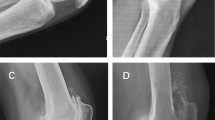Abstract
The fabella has been mainly studied using imaging methods but there are less research reports on the gross anatomical studies. We performed this anatomical study of the fabella and its surrounding structures with functional implications using 150 heads of the gastrocnemius muscles of 75 knees from 39 Japanese cadavers. This study is the direct representation of the human fabella and its functional implications. We observed 99 fabellae (66.0%) including 44 complete bony fabellae (29.3%). Of these bony fabellae, 43 (97.7%) were located in the lateral head of the gastrocnemius muscle with its surrounding structures and were positioned only on the lateral condyle of the femur. Moreover, the cartilage and bony fabellae, especially on the lateral side, contributed to the fabella complex with its surrounding muscles and ligaments and formed small articular cavity by cooperating with the femoral condyle. Although the human fabella is considered as appearing in the fabella complex with ageing and it possibly induces clinical symptoms, the fabella may play an important role as a stabilizer between the fabella complex and the femoral condyle.





Similar content being viewed by others

References
Akansel G, Inan N, Sarisoy T, AnikY, Akansel S (2006) Popliteal muscle sesamoid bone (cyamella): appearance on radiographs, CT and MRI. Surg Radiol Anat 28:642–645
Crouch JE (1969) Text-atlas of cat anatomy. Lea & Fegiger Co., Philadelphia, pp 10–50
Duncan W, Dahm D (2003) Clinical anatomy of the fabella. Clin Anat 16:448–449
Evans HE, Christensen GC (1979) Miller’s anatomy of the dog, Second edn. Saunders, Philadelphia, pp 205–215
Ishigooka H, Sugihara T, Shimizu K, Aoki H, Hirata K (2004) Anatomical study of the popliteofibular ligament and surrounding structures. J Orthop Sci 9:51–58
Kaneko K, Serizawa M, Genda N, Kikkawa F (1967) Einige Betrachtungen über die Fabella des Menschen. Acta Anat Nippon 42:61–62 (only Japanese abstract)
Kaneko U (1982) Nippon human anatomy, vol. 1, 12 edn. Nanzando Co., Tokyo, pp 207–238, pp 497–514 (in Japanese)
Kato Y, Yamauchi S (2003) Atlas of comparative anatomy in domestic animals. Yokendo, Tokyo, pp 128–163 (in Japanese)
Kubota Y, Toyoda Y, Kubota H, Kawai H, Yamamoto T (1986) Common peroneal nerve palsy associated with the fabella syndrome. Anesthesiology 65:552–553
Kuur E (1986) Painful fabella. A case report with review of the literature. Acta Orthop Scand 57:453–454
Larson JE, Becker DA (1993) Fabellar impingement in total knee arthroplasty. A case report. J Arthroplasty 8:95–97
Legendre P, Fowles JV, Godin D (1986) Chondromalacia of the fabella: a case report. Can J Sur 29:102–103
Marks PH, Cameron M, Regan W (1998) Fracture of the fabella: a case of posterolateral knee pain. Orthopedics 21:713–714
Masuda S, Fujita H, Iwamoto M, Kataoka O (1975) Three cases of peroneal nerve palsy possibly due to the fabella. Orthop Surg 26:1517–1522
Matsuzaki A, Iwakiri T, Okue A (1972) Three cases of peroneal nerve palsy possibly due to the fabella. Orthop Surg 23:209–212
Minowa T, Murakami G, Kura H, Suzuki D, Han SH, Yamashita T (2004) Does the fabella contribute to the reinforcement of the posterolateral corner of the knee by inducing the development of associated ligaments? J Orthop Sci 9:59–65
Minowa T, Murakami G, Suzuki D, Uchiyama E, Kura H, Yamashita T (2005) Topographical histology of the posterolateral corner of the knee, with special reference to laminar configurations around the popliteus tendon: a study of elderly Japanese and late-stage fetuses. J Orthop Sci 10:48–55
Miura M, Kato S, Yamaguchi T, Aso K (2001) On the kinematic significance of the human popliteal muscle in the posterolateral structures: an anatomical study. Kyushu Yamuguchi Sports J 13:10–16 (in Japanese with English abstract)
Orhan IO, Haziroglu RM, Gultiken ME (2005) The ligaments and sesamiod bones of knee joint in New Zealand rabbits. Anat Histol Embryol 34:65–71
Popesko P (1977) Atlas of topographical anatomy of the domestic animals, vol. 3, second edn, WB Saunders Co, Philadelphia, pp 5–205
Sarin VK, Erickson GM, Giori NJ, Bergman AG, Carter DR (1999) Coincident development of sesamoid bones and clues to their evolution. Anat Rec 257:174–184
Sekiya JK, Jacobson JA, Wojtys EM (2002) Sonographic imaging of the posterolateral structures of the knee: findings in human cadavers. Anthroscopy 18:872–881
Theodorou SJ, Theodorou DJ, Resnick D (2005) Painful stress fractures of the fabella in patients with total knee arthroplasty. Am J Roentgenol 185:1141–1144
Torisu T, Kokubun S (2005) Standard textbook orthopedics. Igaku-shoin, Tokyo, pp 559–564 (in Japanese)
Weiner DS, Macnab I (1982) The “Fabella syndrome”: an update. J Pediatr Orthop 2:405–408
Acknowledgments
This study was supported by grants from the Scientific Research from the Ministry of Education, Culture, Sports Science and Technology (MEXT) (No. 16790804, 2004–2006 and No. 19790985, 2007–2009), and the Japan Society for the Promotion of Science (JSPS) core-to-core program HOPE (2005–2007).
Author information
Authors and Affiliations
Corresponding author
Rights and permissions
About this article
Cite this article
Kawashima, T., Takeishi, H., Yoshitomi, S. et al. Anatomical study of the fabella, fabellar complex and its clinical implications. Surg Radiol Anat 29, 611–616 (2007). https://doi.org/10.1007/s00276-007-0259-4
Received:
Accepted:
Published:
Issue Date:
DOI: https://doi.org/10.1007/s00276-007-0259-4



